Thank you for visiting! By the way… any links on this page that lead to products on Amazon and other stores/partners are affiliate links Aquarium Store Depot earns a commission if you make a purchase.
Imagine a world where your aquarium fish coexist peacefully, stress and aggression are minimized, and you can enjoy a diverse and thriving habitat right in your living room. Sounds too good to be true? Well, it’s not – with the help of dither fish! These small, active fish play a crucial role in reducing stress and aggression for larger, timid fish in freshwater tanks. Get ready to dive into the fascinating world of dither fish, learn their purpose, benefits, and the best species for different aquarium setups.
Key Takeaways
- Dither fish provide security and activity to larger, shy fish in aquariums, reducing stress & aggression.
- Livebearers, danios, tetras and more make great additions to any tank for a peaceful environment.
- Feeding tips & alternative methods of reducing stress should also be considered when selecting species for an aquarium setup.
Understanding Them: Their Purpose and Benefits
Dither fish play an essential role in aquariums as they provide safety and liveliness to larger, timid species of cichlids such as dwarf cichlids or medium sized cichlids1. By signaling security for more bashful creatures living within the same habitat, these underwater heroes create a peaceful ambiance with reduced stress levels throughout different kinds of fish species.
Without dither inhabitants present in tanks, their passive counterparts usually appear pale colored due to anxiousness along with decreased appetites, which would eventually destabilize the ecosystem balance among individuals belonging to this category that fearfully lurk around habitats without their presence.
Dither Fish Vs. Target Fish
Fish play an important role in creating a healthy aquarium environment, and two particular types – dither fish and target fish, offer unique advantages. Dithers help to reduce stress between multiple occupants as well as act as a decoy for potential predators while inspiring more security among the other tank dwellers.
On the other hand, peaceful or “target” species serve to soften aggression within tanks by redirecting aggression to them (other times, feeder fish are used as target fish). While this may help the territorial or aggressive fish, this is not an ethically sound ideal as the fish targeted will become stressed. This could lead to illness or even death of the fish dude due to constant harassment.
We recommend only using dither fish to bring out fish, not to be used as target species.
The 12 Best Dither Fish For Different Aquarium Setups
A wide variety of fish species is suitable for different kinds of aquariums, each possessing exclusive attributes and advantages. For each species, we will list out the following:
- Scientific name
- Care level
- Minimum tank size
- Temperament
- Adult fish size
- Origin
- Temperature
- pH
- Diet
- Swim Level
We have a video just from you from our YouTube channel that you can follow along. If you like our content, be sure to give us a thumbs up and subscribe. We post new videos every week!
1. Livebearers
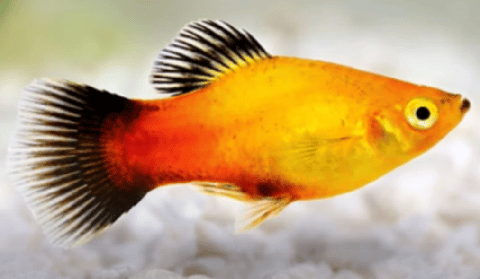
- Scientific name: Various
- Care level: Easy
- Minimum tank size: 10 gallons
- Temperament: Peaceful
- Adult fish size: 2.5 inches
- Origin: South and North America
- Temperature: 62 – 82 °F
- pH: 6.0 – 8.0
- Diet: Omnivore
- Swim Level: Top & Mid-water
Livebearers are popular in aquariums, such as guppies and mollies, because they reduce tension between more aggressive species. They give birth to live young instead of laying eggs and will happily breed inside your aquarium. These creatures require minimal maintenance, making them perfect for any watery habitat Plus, their active swimming creates an attractive atmosphere due to their colors and good temperaments..
Livebearers include the following species from smallest to largest. You can purchase the species that best fits your tank size:
2. Danio Fish

- Scientific name: Danio spp
- Care level: Easy
- Minimum tank size: 10 gallons
- Temperament: Peaceful
- Adult fish size: 1 – 4 inches
- Origin: India mostly
- Temperature: 64 – 75 °F
- pH: 6.0 – 8.0
- Diet: Omnivore
- Swim Level: Top & Mid-water
Danios are perfect for infusing energy into any aquarium. These colorful, peaceful fish flock together and tend to be quite active swimmers, which promotes a more secure environment for shy inhabitants of the tank. Not only do these energetic schooling fish put on an entertaining show inside the aquarium, but they can be mixed with a variety of fish. They are voracious eaters, so keep that in mind if you have slow eating fish. It would be best to feed them separately if your other fish are slower feeding.
3. Tetras

- Scientific name: Paracheirodon spp
- Care level: Easy to moderate
- Minimum tank size: 10 gallons and up
- Temperament: Peaceful
- Adult fish size: 1 – 3 inches
- Origin: South America mostly
- Temperature: 68 – 82 °F
- pH: 6.0 – 7.5 usually
- Diet: Omnivore
- Swim Level: Top & Mid-water
Tetras are popular schooling fish renowned for their colorful appearances and outstanding abilities as dithers. Their activity encourages shy or timid species to come out of hiding with ease due in part to the peaceful nature of these fish. Tetras school well with each other, with the Rummy Nose being one of the tightest schooling fish available in the hobby. Tetras are considered a top 5 dither fish species (though our list expands to more).
This type of fish is incredibly diverse when it comes to diet – they eat anything from flakes/pellets, live food down to frozen options- which makes them perfect for various freshwater aquarium setups. With their stunning colors and resilience, tetras make a wonderful addition to any tank! They are best in large schools where they will make your other fish feel safe. Here are several tetras that are great choices for a community tank:
- Neon tetras
- Cardinal tetra
- Black neon tetra
- Congo tetra
- Rummy nose tetra
4. Hatchetfish
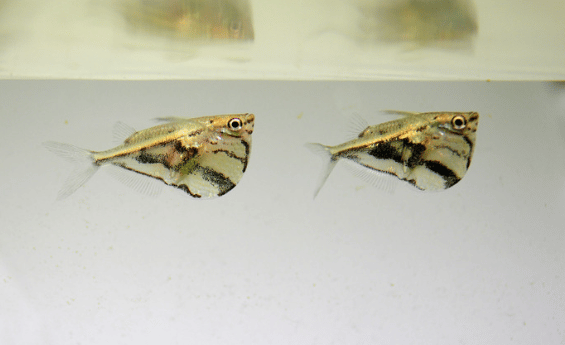
- Scientific name: Gasteropelecus sternicla
- Care level: Moderate
- Minimum tank size: 20 gallons
- Temperament: Peaceful
- Adult fish size: 1.5 inches
- Origin: South America
- Temperature: 72 – 81 °F
- pH: 6.0 – 7.5
- Diet: Omnivore
- Swim Level: Top & Mid-water (surface dwellers)
Hatchetfish, native to South America, are popular aquarium fish due to their slim and hatchet-shaped appearance. The schooling and surface dwelling behavior of this species set them apart from the rest in terms of dither fish. They possess a unique ability that is quite similar to flying fish. It allows them assistive glides as they pursue insects or evade predators in the wild. It’s recommended that one keep six or more Hatchetfish together for ideal viewing pleasure as well as establishing an inviting habitat that will bring out their natural behaviors even further.
5. Rasboras

- Scientific name: Various
- Care level: Easy to Moderate
- Minimum tank size: 5 gallons and up
- Temperament: Peaceful
- Adult fish size: 0.75 to 2 inches
- Origin: Asia usually
- Temperature: 62 – 82 °F
- pH: 6.0 – 7.5 usually
- Diet: Omnivore
- Swim Level: Top & Mid-water
Rasboras are ideal for providing a secure and comfortable environment in freshwater tanks. With their speed, agility, and colorful appearances, these schooling fish can help more timid species feel safe. They also contribute to the harmony in the aquarium due to their gentle behavior. Introducing rasboras into your tank gives all other inhabitants peace of mind and adds vibrant visual appeal. Some of these species are very small, so make sure they are housed with appropriately sized fish.
6. Corydoras Catfish

- Scientific name: Corydoras spp.
- Care level: Easy to Moderate
- Minimum tank size: 10 gallons and up
- Temperament: Peaceful
- Adult fish size: 1 to 4 inches
- Origin: South America usually
- Temperature: 70 – 81 °F
- pH: 6.0 – 7.5 usually
- Diet: Omnivore
- Swim Level: Bottom
Corydoras catfish are excellent for keeping community tanks clean and providing an aesthetically pleasing presence in the aquarium. These fish bring peace to their surroundings as they scavenge along the bottom of the tank, never becoming aggressive or disruptive to other inhabitants. They should have many places to hide to feel safe when at rest. A balanced diet is necessary for these lively dithers’ health and happiness. Owners must keep up with regular maintenance on both tank water quality and nutritional needs alike.
When properly taken care of, Corydoras Catfish can make a great addition to any aquatic setup due to their helpful duties and how attractive this species appears swimming around its home aquarium! Keep in mind if you are working with a fish that is territorial and claims the bottom of the tank, they should not be housed together. Use dither fish that are middle or top swimmers instead.
7. Rainbowfish
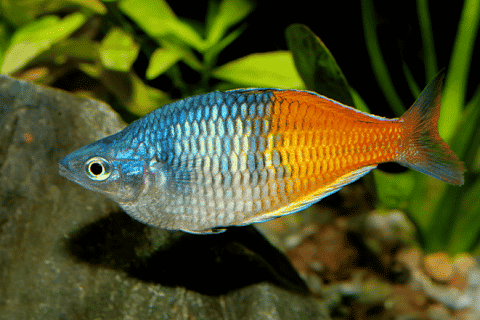
- Scientific name: Melanotaenia Spp.
- Care level: Easy to Moderate
- Minimum tank size: 20 gallons and up
- Temperament: Peaceful
- Adult fish size: 2.5 to 5 inches
- Origin: Indonesia, Eastern Australia, Northern Australia, North Carolina
- Temperature: 74 – 80 °F
- pH: 6.0 – 8.0
- Diet: Omnivore
- Swim Level: Middle to Top
Rainbowfish are one of the most popular fish species among aquarists, thanks to their colorful, hardy nature that enhances the aquarium environment. These fish are more adaptable to tank chemistry parameters than other dither fish. They can work in acidic community tanks and alkaline Rift Lake Cichlid setups. Their ability to thrive under a variety of water conditions makes them an ideal choice for even beginner owners looking to liven up their tank with multiple types of aquatic life, reducing any potential stress or aggression between other fish varieties present in your underwater world.
They are also on the larger end, which allows you to use them with most medium sized fish. They are great with species like Angelfish.
8. Pencilfish
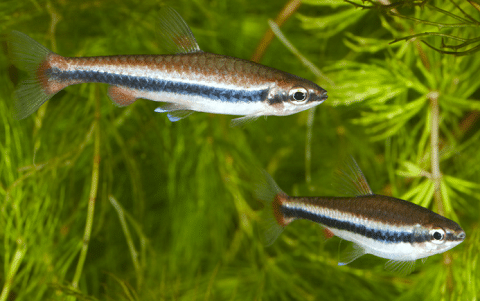
- Scientific name: Nannostomus spp.
- Care level: Easy to Moderate
- Minimum tank size: 10 gallons and up
- Temperament: Peaceful
- Adult fish size: 1 to 2 inches
- Origin: Indonesia, South America
- Temperature: 64 – 82 °F
- pH: 6.0 – 7.5
- Diet: Omnivore
- Swim Level: Middle to Top
Pencilfish are an excellent choice to add to your tank as they help timid and shy fish feel more comfortable coming out of hiding due to their outgoing nature and swimming in the open water.
They are schooling fish with a low energy level than others on this list. They are excellent for fish that may get outcompeted for food and give an alternative look than what you usually see with tetra or rasboras schools
9. Silver Dollars
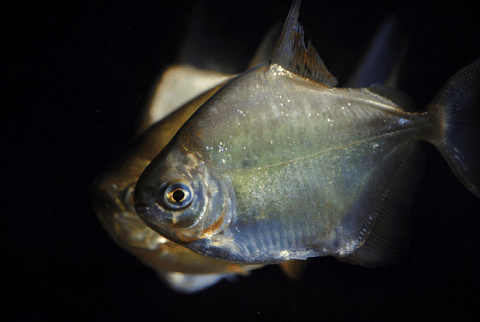
- Scientific name: Metynnis argenteus / Metynnis hypsauchen
- Care level: Moderate
- Minimum tank size: 75 gallons
- Temperament: Peaceful
- Adult fish size: 6 inches
- Origin: South America
- Temperature: 75 – 82 °F
- pH: 6.0 – 7.0
- Diet: Omnivore
- Swim Level: Middle to Top
Silver dollars are native to South America and can be used in larger tanks due to their schooling behavior. These fish have a unique mirrored appearance on the flanks, which allows them fast movements that help them evade predators. They prefer warm, acidic waters and will add an attractive element of motion with their swiftness within any tank setting. To ensure they stay healthy, it is important for silver dollars to consume both plant-based food as well as protein sources regularly. They fast and larger size make them perfect for aggressive fish like the Jack Dempsey.
10. Small To Medium Barb Fish

- Scientific name: Various
- Care level: Easy to Moderate
- Minimum tank size: 15 gallons
- Temperament: Peaceful to Semi-aggressive
- Adult fish size: 2 – 4 inches
- Origin: Various
- Temperature: 68 – 80 °F
- pH: 6.0 – 8.0
- Diet: Omnivore
- Swim Level: Middle to Top
Small to medium barbs, such as gold or cherry barbs are an excellent choice of schooling fish when looking for dithers in aquarium setups. These vibrant and patterned fish boast speed, energy, and life that help create a peaceful atmosphere among other species living with them. As they provide beautiful colors, these small to medium size organisms can add charm while keeping the tank lively at the same time.
Barbs range in temperament. Keep peaceful barbs like cherries with more delicate fish while using tiger barbs for more semi-aggressive to aggressive setups.
11. Bala Shark
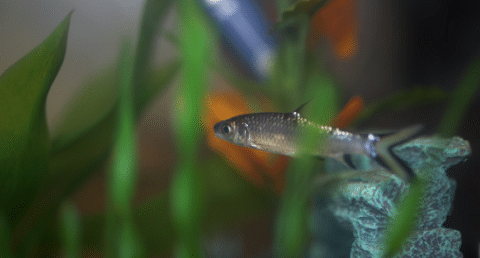
- Scientific name: Balantiocheilos melanopterus
- Care level: Moderate
- Minimum tank size: 125 gallons
- Temperament: Peaceful (will eat small fish)
- Adult fish size: 12 inches
- Origin: Southeast Asia – found in rivers and lakes of Thailand, Borneo, Sumatra, and Malaysia
- Temperature: 75 – 82 °F
- pH: 6.5 – 8.0
- Diet: Omnivore
- Swim Level: Middle to Top
Bala sharks are an ideal choice for large community tanks as they offer great value, can handle freshwater conditions easily, and will get along with some of the largest fish in the hobby. Unfortunately, this species is known to be quite aggressive with its fin nipping habits. Yet it doesn’t stop them from being used in groups where other fish inhabit the same tank – just so long as there’s enough space available. They require large tanks, with 125 being the minimum. They are one of the go tos for those who want a monster fish tank with dither fish.
12. Tinfoil Barb
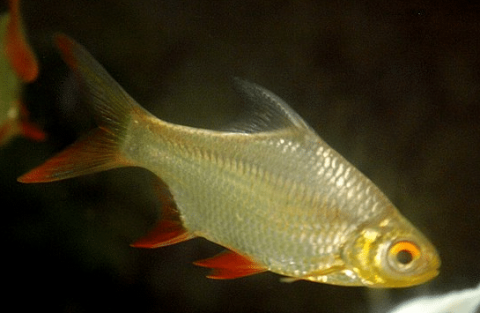
- Scientific name: Barbonymus schwanenfeldii
- Care level: Moderate
- Minimum tank size: 125 gallons
- Temperament: Semi aggressive
- Adult fish size: 15 inches
- Origin: Tropical regions in Borneo, Sumatra, Thailand, and the Malayan peninsula
- Temperature: 72 – 77 °F
- pH: 6.5 – 7.5
- Diet: Omnivore
- Swim Level: All
Tinfoil barbs are an eye catching schooling fish with a shiny coating and attractive red fins. They are omnivorous, feasting on plant matter and protein based foods like shrimp. It is essential to give them ample space in their aquariums to avoid nipping at other slower fish that may inhabit the tank too.
They are large fish that require an even larger tank than Bala Sharks. These are the one of the biggest dither fish you can purchase in the hobby. They are reserved for the largest fish keepers.
Feeding And Care Tips
Taking proper care of your dither fish is essential for their health. To meet their dietary requirements, offer a range of foods like flakes, pellets, and frozen food items, and live feed to them in several smaller amounts throughout the day. Dither fish, given their activity levels, will need to be fed more often than other fish in your tank. Also, pay attention to maintaining the right water temperature and pH level along with salinity and hardness that are suitable according to the type of species inside your aquarium or tank environment.
Regular water changes must be done routinely if parameters are off. In general, try to stick with these parameters and make water changes if they are off:
Alternative Methods For Reducing Stress And Aggression
There are alternatives to relying solely on dither fish for an active and peaceful tank. One solution is planning the aquarium setup correctly with adequate hiding places and sticking to generally peaceful fish that aren’t territorial.
Introducing compatible new inhabitants gradually is another way to limit stress levels when establishing harmony among all the fish in that environment. Consequently, by employing these methods, you will be able to promote peaceful vibes for your finned friends thriving in their own self-made habitat.
Potential Drawbacks Of Using Dither Fish
When incorporating dither fish into an aquarium, there are many advantages to be had in the reduction of stress and hostility among its inhabitants. Nonetheless, it is important to weigh up potential problems that may arise when introducing different species together, such as a timid variety being provoked by another type or breeding if the same genders remain close proximity. Overcrowding could also become problematic, given they require adequate room for safety from assault and optimal health conditions.
Ethically speaking, questions have arisen over using target fish or feeder varieties due to conditions these fish face if they are used as target fish. The stress can cause disease or death. It’s best to work on the aggression issues with a larger tank or to reduce the number of aggressive fish to reduce aggression in the tank.
Where To Buy
Many dither fish are small and can be purchased at local fish stores. However, if you lack a reliable store near you, you can consider purchasing them online. We highly recommend getting any nano fish from Flip Aquatics as they quarantine all their fish and offer guarantees. You can shop at them by clicking the click below.
Use Promo Code ASDFLIPPROMO
Founded in 2010. Robert and his team at Flip Aquatics have set the standard for conditioned freshwater fish. One of the best selections of freshwater shrimp and nano fish on the internet
Fish That Benefit
Here are several fish species that benefit from these fish. Consider them if you are thinking about housing any of these species below:
- Discus Fish
- Paradise fish and Gouramis
- Angelfish (reduces infighting)
- Knifefish
- Apistogrammas
Frequently Asked Questions
What is the dither effect on fish?
Adding dither fish to your aquarium can give other occupants the security and assurance they need in order to swim more freely. As these small swimming creatures act as natural decoys, they help reduce predator activity and encourage regular behavior amongst all of the tank inhabitants. This type of fish brings many benefits with them into any aquatic environment. Creating a sense of safety that allows for unrestricted exploration by other species within the space.
What dither fish can live in a discus tank?
Cardinal tetras, which require warm and acidic water like larger fish that live within a tank, are often used as dithers in an aquarium. Being peaceful creatures, these small schooling fish have a calming effect on their bigger peers while swimming freely around it all day.
Do guppies make good dither fish?
For any community aquarium, guppies are a great option as a dither fish. The only drawbacks with them are fancy guppies may get nipped by tankmates, and they have the ability to breed quickly. Otherwise, they are a popular and great dither fish to add to the aquarium.
What is the best dither fish?
The ideal fish for shy or aggressive species are livebearers, tetras and rasboras, corydoras, danios, and rainbowfish, as well as hatchetfish and pencil fish. These types of fishes are the best options to act as ‘dithers.’
What is the main purpose of dither fish in an aquarium?
Fish known as dither fish can bring a feeling of protection and increased activity to other inhabitants in an aquarium, thus reducing levels of anxiety or aggression.
Closing Thoughts
Keeping the environment of your aquarium in harmony is essential, and dither fish play an important part by reducing tension amongst aquatic inhabitants. By getting to know different species of these fish, providing them with care and proper nutrition, and considering alternative tactics for decreasing aggression, you can guarantee that your freshwater tank is cheerful and vibrant. So why not take advantage of what dither fish have to offer?
Have you kept any before? Let us know in the comments about your experience. Until next time fish keepers!
- About the Author
- Latest Posts
I’m thrilled that you found Aquarium Store Depot! Here you’ll find information on fish, aquariums, and all things aquatics related. I’m a hobbyist (being doing this since I was 11) and here to help other hobbyists thrive with their aquariums! I adhere to a high quality Editorial Process and Review products with real life field usage and practical analysis.






